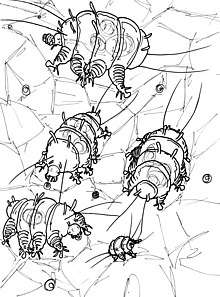Sialomorpha
Sialomorpha dominicana, also known as the mold pig, is a genus of incertae cedis panarthropodan discovered in 30-million year old Dominican amber by George Poinar at Oregon State University and Diane R. Nelson at East Tennessee University.[1][2] It was placed in a new genus and family (Sialomorphidae) unto itself, and appears to represent a new phylum. S. dominicana shares some resemblance to tardigrades and mites.[3] It is about 100 µm long and grew by molting its exoskeleton.[4] It was probably an omnivore, feeding on minute invertebrates and fungi, including mold.[1]
| Sialomorpha | |
|---|---|
 | |
| Artist's restoration | |
| Scientific classification | |
| Kingdom: | Animalia |
| (unranked): | Panarthropoda |
| (unranked): | incertae sedis |
| Family: | †Sialomorphidae Poinar & Nelson, 2019 |
| Genus: | †Sialomorpha Poinar & Nelson, 2019 |
| Species: | †S. dominicana |
| Binomial name | |
| †Sialomorpha dominicana Poinar & Nelson, 2019 | |
References
- Poinar, George; Nelson, Diane R. (September 28, 2019). "A new microinvertebrate with features of mites and tardigrades in Dominican amber". Invertebrate Biology. 138 (4). doi:10.1111/ivb.12265. ISSN 1077-8306.
- Dvorsky, George (October 9, 2019). "You've Heard Of Water Bears, But How About These Ancient Mould Pigs?". Gizmodo. Retrieved October 9, 2019.
- Irving, Michael (October 8, 2019). "Newly discovered "mold pigs" don't fit into any known animal group". New Atlas. Retrieved October 9, 2019.
- News Staff (October 9, 2019). "Mold Pigs: Strange Creatures with Features of Mites and Tardigrades Found in Amber". Sci News. Retrieved October 9, 2019.
This article is issued from Wikipedia. The text is licensed under Creative Commons - Attribution - Sharealike. Additional terms may apply for the media files.